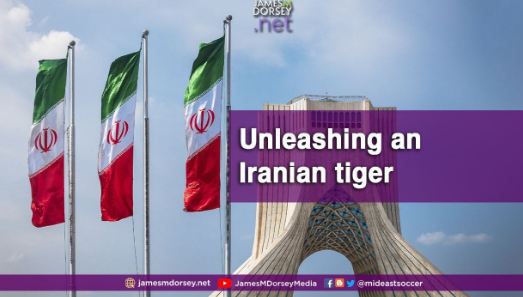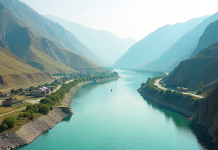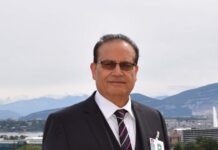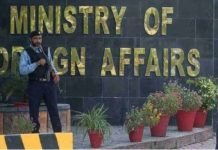A Gulf investor with an analytical and artistic bent, Ali al-Salim pinpointed the long-term challenges Saudi Arabia faces as it reestablishes relations with Iran.
While most analysts focused on the immediate reduction of regional tensions and the possible opening for an end to the eight-year-long Saudi military intervention in Yemen as a result of a Chinese-mediated agreement to restore diplomatic relations between two Middle Eastern arch-rivals, Mr. Al-Salim is looking at Iran’s long-term competitive edge compared to the kingdom.
“As relations between Saudi and Iran begin to thaw, the logic for Saudi’s ambitious ‘Trojena’ ski resort will come further into question. Iran boasts world-class ski resorts an hour from Tehran and 90km of slopes. Oh, and it’s all natural, even the snow,” Mr. Al-Salim said on Twitter.
Mr. Al-Salim was referring to a yet-to-be-built resort on mountain peaks overlooking Neom slated to be home to 7,000 people by 2026 and annually attract 700,000 visitors. Trojena would be the Gulf’s first outdoor ski resort.
Neom is Saudi Crown Prince Mohammed bin Salman’s US$500 billion fantasia. It is a futuristic science-fiction-like new city and tourism destination along the Red Sea in a mostly unpopulated part of the kingdom.
Somewhat incongruously, the Olympic Council of Asia has awarded Trojena the right to host the 2029 Asian Winter Games.
In contrast to Iran’s up to 5,600-metre high, 600-kikometer-long Alborz mountain range that stretches along the Caspian Sea, snow falls occasionally on Trojena’s 2,400-metre high Sarawat mountains.
To compensate for its shortage, Trojena plans to create an outdoor ski slope by blasting artificial snow on the mountains. This slope would be powered by renewable energy.
In Mr. Al-Salim’s mind, Trojena appears to be emblematic of the broader challenge posed by an Iran that eventually is freed of the shackles of crippling US sanctions and has rebuilt its economy.
Unshackled and recovered, Iran brings to the table much that Saudi Arabia has and more. With a population close to 90 million, Iran is almost three times the size of the kingdom. It ranks as the world’s third-largest oil and second-largest natural gas reserve holder.
Beyond boasting one of the Middle East’s largest domestic markets, an innovative and technology-savvy youth, a deep-seated identity rooted in empire, and a battle-hardened military, Iran occupies strategic geography at the crossroads of Central Asia, the Middle East and Europe, and a coastline along the Arabian Sea, the western end of the Indo-Pacific.
To be sure, Iran has a long way to go to fully capitalize on its assets with no immediate prospect of its clerical regime doing what it would take to persuade the United States to lift sanctions, rebuild confidence with its neighbors, including Saudi Arabia, and introduce necessary political, economic, and social reforms.
As a result, Saudi Arabia has a first-starter advantage, which Mr. Bin Salman is bent on exploiting with his social reforms and efforts to diversify the Saudi economy to reduce the kingdom’s dependence on oil exports, of which Trojena is one building block.
Even so, the restoration of diplomatic relations with Saudi Arabia constitutes a first step to strengthen the Iranian economy. This would enable Iran to position itself as not just a formidable political rival but also an economic competitor.
“Evidently, de-escalation will reduce the cost of regional security for all parties and free up more potential for trade and cross-border investments and partnerships that the region needs,” said Bijan Khajehpour, a keen observer of the Iranian economy.
Iranian hopes have been buoyed by plans by the United Arab Emirates to boost annual trade with Iran to US$30 billion in the next two years, up from $20 billion in 2022, Emirati interest in Iranian infrastructure, including the strategic Arabian Sea port of Chahbahar, and prospects for Saudi investment in the Islamic republic.
Saudi Finance Minister Mohammed al-Jadaan recently told a private sector forum of Saudi Arabia’s sovereign wealth fund that investment in Iran could happen “very quickly.”
Optimistically, Mr. Al-Jadaan went on to say that “there are a lot of opportunities for Saudi investments in Iran. We don’t see impediments as long as the terms of any agreement would be respected.”
Mr. Al-Jadaan’s remarks did not refer to US sanctions, the elephant in the room. Instead, he hinted at Iran’s need to clean up multiple legal and operational ambiguities that pose obstacles to foreign investment, even without considering externally imposed restrictions.
Laying out a roadmap for Saudi and Gulf investment in Iran, Mr. Khajehpour suggested that initially, investors could target non-sanctioned industries, such as food and pharmaceuticals while developing “creative banking and financial solutions” that would enable circumvention of sanctions.
Furthermore, Mr. Khajehpour held out the possibility that the United States could provide waivers for investments that address water scarcity and climate change.
If and when sanctions are lifted, the sky is the limit.
Opportunities range from cooperation on petroleum products and petrochemicals, development of an offshore Saudi-Iranian-Kuwaiti gas field, and connecting electricity grids, to investment in transportation linkages, according to Mr. Khajehpour.
Saudi interest in getting in on the ground floor of Iran’s eventual reemergence extends beyond geopolitical, security, economic, and commercial considerations.
Economic cooperation has the potential to blunt the impact of an unleashed Iran by making the kingdom a partner.
“Iran’s rise is inevitable. When it happens, the Middle East will be a different place. Saudi Arabia knows that. It sees the short- and long-term benefits of recalibrating relations with Iran. Iran hasn’t quite thought that far but ultimately it will,” said a European official who closely monitors Middle Eastern developments.
Thank you for joining me today. I hope you enjoyed the newsletter and/or podcast. Diplomats, policymakers, investors, executives, journalists and academics listen to my twice-weekly podcast and/or read my syndicated newsletter that is republished by media across the globe. Maintaining free distribution ensures that the podcast and newsletter have maximum impact Paid subscribers help me cover the monthly cost of producing the newsletter and podcast. Please consider becoming a paid subscriber. You can do so by clicking on Substack on the subscription button at www.jamesmdorsey.substack.com and choosing one of the subscription options or support me on Patreon at www.patreon.com/mideastsoccer. Please join me for my next podcast in the coming days. Thank you, take care and best wishes.
Dr. James M. Dorsey is an award-winning journalist and scholar, an Adjunct Senior Fellow at Nanyang Technological University’s S. Rajaratnam School of International Studies, and the author of the syndicated column and podcast, The Turbulent World with James M. Dorsey.

















